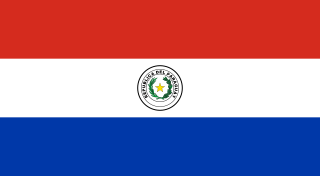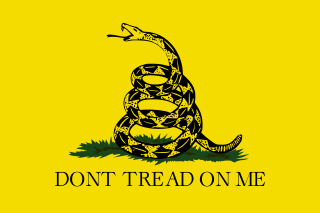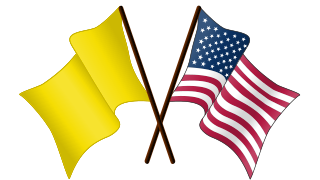
Crawford County is a county located in the central portion of the U.S. state of Georgia. As of the 2020 census, the population was 12,130. The county seat is Knoxville.

The flags of the Confederate States of America have a history of three successive designs during the American Civil War. The flags were known as the "Stars and Bars", used from 1861 to 1863; the "Stainless Banner", used from 1863 to 1865; and the "Blood-Stained Banner", used in 1865 shortly before the Confederacy's dissolution. A rejected national flag design was also used as a battle flag by the Confederate Army and featured in the "Stainless Banner" and "Blood-Stained Banner" designs. Although this design was never a national flag, it is the most commonly recognized symbol of the Confederacy.

The flag of the U.S. state of Georgia bears three horizontal stripes and features a blue canton containing a ring of 13 white stars that encircle the state's gold-colored coat of arms. The ring of stars that encompass the state's coat of arms represents Georgia as one of the original Thirteen Colonies. Its current iteration was adopted on February 19, 2003. The arch symbolizes the state's constitution while the pillars represent the three branches of government. The words of the state motto, "Wisdom, Justice, and Moderation", are wrapped around the pillars, guarded by a figure dressed in colonial attire from the American Revolutionary War. Within the arms, a sword is drawn to represent the defense of the state's constitution with the motto of the United States, "In God We Trust", featured below these elements.

William Moultrie was an American slaveowning planter and politician who became a general in the American Revolutionary War. As colonel leading a state militia, in 1776 he prevented the British from taking Charleston, and Fort Moultrie was named in his honor.

The Lone Star Flag is the official flag of the U.S. state of Texas. The flag, flown at homes and businesses statewide, is highly popular among Texans and is treated with a great degree of reverence and esteem within Texas. Along with the flag of Hawaii, it is one of two state flags to have previously served as a national flag of an independent country. In 2001, the North American Vexillological Association surveyed its members on the designs of the 72 U.S. state, territorial, and Canadian provincial flags and ranked the Texas flag second, behind New Mexico.

The concept of liberty has frequently been represented by personifications, often loosely shown as a female classical goddess. Examples include Marianne, the national personification of the French Republic and its values of Liberté, Égalité, Fraternité, and the female Liberty portrayed in artworks, on United States coins beginning in 1793, and many other depictions. These descend from images on ancient Roman coins of the Roman goddess Libertas and from various developments from the Renaissance onwards. The Dutch Maiden was among the first, re-introducing the cap of liberty on a liberty pole featured in many types of image, though not using the Phrygian cap style that became conventional. The 1886 Statue of Liberty by Frédéric Auguste Bartholdi is a well-known example in art, a gift from France to the United States.

The flags of the U.S. states, territories, and the District of Columbia exhibit a variety of regional influences and local histories, as well as different styles and design principles. Modern U.S. state flags date from the turn of the 20th century, when states considered distinctive symbols for the 1893 World's Columbian Exposition in Chicago, Illinois. Most U.S. state flags were designed and adopted between 1893 and World War I.

The national flag of the Dominican Republic is one of the official national symbols of the nation, along with the coat of arms and the national anthem. The blue on the flag stands for liberty, the white for salvation, and the red for the blood of heroes. The civil flag follows the same design, but without the charge in the center. The flag was designed by Juan Pablo Duarte.

The current design of the flag of Paraguay was first adopted in 1842. Its design, a red–white–blue triband, was inspired by the colours of the French Tricolour, believed to signify independence and liberty. The flag is unusual because it differs on its obverse and reverse sides: the obverse of the flag shows the national coat of arms, and the reverse shows the seal of the treasury. It is the only national flag worldwide that has a unique design on each side. The flag consists of the same three horizontal colours as the flag of the Netherlands, which in turn was the inspiration for the French flag. It was revised in 2013 to bring the flag towards its original design. It has a ratio of 11:20.

The Great Seal of the State of Hawaii was designated officially by Act 272 of the 1959 Territorial Legislature and is based on the territorial seal. Modifications to the territorial seal included the use of the words "State of Hawaii" at the top and "1959" within the circle. Provisions for a seal for the state of Hawaii were enacted by the Territorial Legislature and approved by Governor William F. Quinn on June 8, 1959. The passage of the Admission Act in 1959, admitted Hawaii as the 50th State of the United States of America on August 21, 1959.

The Gadsden flag is a historical American flag with a yellow field depicting a timber rattlesnake coiled and ready to strike. Beneath the rattlesnake are the words Dont Tread on Me. Some modern versions of the flag include an apostrophe.

"The Bonnie Blue Flag", also known as "We Are a Band of Brothers", is an 1861 marching song associated with the Confederate States of America. The words were written by the entertainer Harry McCarthy, with the melody taken from the song "The Irish Jaunting Car". The song's title refers to the unofficial first flag of the Confederacy, the Bonnie Blue Flag. The left flag on the sheet-music is the Bonnie Blue Flag.

The Seal of the State of Texas was adopted through the 1845 Texas Constitution, and was based on the seal of the Republic of Texas, which dates from January 25, 1839.

"Come and take it" is a long-standing expression of defiance first recorded in the ancient Greek form molon labe "come and take [them]", a laconic reply supposedly given by the Spartan King Leonidas I in response to the Persian King Xerxes I's demand for the Spartans to surrender their weapons on the eve of the Battle of Thermopylae in 480 BC. It was later used in 1778 at Fort Morris during the American Revolution, and also in 1835 at the Battle of Gonzales during the Texas Revolution.

The Texian Army, also known as the Revolutionary Army and Army of the People, was the land warfare branch of the Texian armed forces during the Texas Revolution. It spontaneously formed from the Texian Militia in October 1835 following the Battle of Gonzales. Along with the Texian Navy, it helped the Republic of Texas win independence from the Centralist Republic of Mexico on May 14, 1836 at the Treaties of Velasco. Although the Texas Army was officially established by the Consultation of the Republic of Texas on November 13, 1835, it did not replace the Texian Army until after the Battle of San Jacinto.
Liberty or death, Independence or death or similar phrases may refer to:

Joanna Troutman also Johanna Troutman sewed a flag for a battalion of Georgia volunteers who were leaving to fight in the Texas Revolution, which became known as the Troutman flag, consisting of a five-pointed blue star and the words "Liberty or Death" on a white silk field. On the reverse side was the Latin phrase UBI LIBERTAS HABITAT, IBI NOSTRA PATRIA EST which means "Where liberty dwells, there is our fatherland". On January 8, 1836, the flag was raised at Velasco which is now part of modern Freeport, Texas. The original flag was badly damaged by accident and only shreds flew in battle.

The city flag of San Antonio, Texas was originally drawn by Spanish–American War veteran William W. Herring on May 28, 1933. The design saw significantly more usage than the official flag, but was never officially adopted until 1976. The current flag is a slightly modified version of Herring's design, most notably removing the text formerly displayed.

Troutman Pepper Locke LLP is an American law firm with more than 1,600 attorneys located in 33 U.S. cities. In terms of revenue, Troutman Pepper placed 47th on The American Lawyer's 2022 AmLaw 100 rankings of U.S. law firms, with $1,029,503,000 in gross revenue in 2021.



















